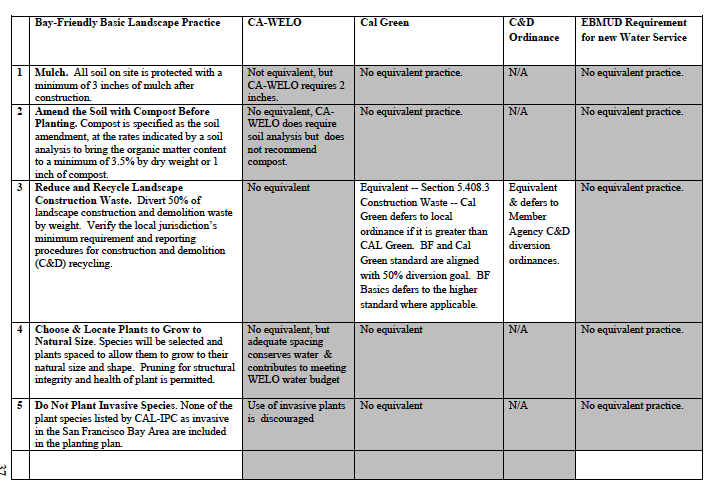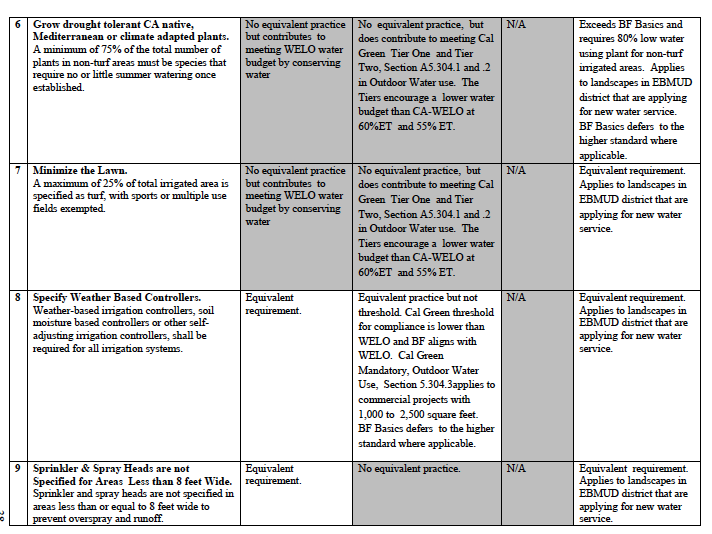Jun 17 2012
“Landscaping must conform to guidelines …..”
Revisions to a proposed Piedmont landscaping ordinance drafted by StopWaste.org will be considered by the City Council at its June 18 meeting. Slight revisions to Section 17.18 have been proposed by the City planning staff in an effort to address some of the private property concerns raised by the public and Council Members at a June 4 Council meeting regarding hedges, lawns, plant specifications, local control, and cost. Perhaps in error, Chapter 17.18.3. (a.ii) still defines all use of the term, “Bay-Friendly Landscaping Guidelines means the most recent version of guidelines developed by Stopwaste.org”
Chapter 17.11 has not been revised and still refers to the “most recent version” of Stopwaste.org rules. Chapter 17.11 covers “City owned and/or operated” properties, which include the Art Center, Central Park, Moraga Canyon/Blair Park, etc.
The proposed ordinance will require a landscape plan to obtain a permit for any type of new building in Piedmont. At the discretion of the Public Works Director or Planning Commission, a landscape plan may also be required for other types of permits and variances affecting existing landscaping.
“Automatic” Future Restrictions by StopWaste
Residents expressed concerns about future StopWaste restrictions automatically becoming Piedmont law without hearings within the Piedmont community. The Council directed a revision of this language. The Staff Report notes revisions have removed this language for residential and commercial properties, but not City property:
“If Stopwaste.org makes changes to the criteria under the Scorecard, it would not affect any residential or commercial properties in Piedmont, but would affect very large public projects on public land under the existing Civic Bay-Friendly Landscape Ordinance that affects public properties in Zone B.” (At p. 26.)
The Checklist continues to refer to obsolete language in the original model ordinance. The ordinance also continues to use terms not entirely consistent with terms used in other parts of the Piedmont Municipal Code.
Hedge and Lawn Restrictions
Hedge and lawn restrictions were raised as a concern by residents. (See comments.) All restrictions on hedges and lawns remain in the ordinance. Specific plant selections must adhere to the guidelines. However, the type of projects which must comply with the restrictions on hedges and lawns has been limited. Revisions limit compliance with the StopWaste Checklist (version 2.1 dated December 2011) to:
(1) Rehabilitated Landscapes and new construction associated with Rehabilitated Landscapes for public agency projects and private commercial developments that require design review and/or a building permit;
(2) Rehabilitated Landscapes and new construction associated with Rehabilitated Landscapes which are developer-installed in multifamily developments that require design review and/or a building permit; and
(3) Construction of a new single-family residence on a vacant property which is homeowner-provided and/or homeowner-hired that includes a total project Landscape Area equal to or greater than 5,000 square feet, and that requires design review and/or a building permit.
“Multi-family” will include private homes with legal second units, and also homes with illegal and unintended second units if conversion to a legal unit during the process of obtaining a permit is proactively undertaken by the homeowner or staff pursuant to newly adopted 2011 Housing Element provisions.
Residents are required to obtain a building permit when landscaping plans include installation of a 30 inch retaining wall, demolition of an existing potting shed, erecting fences or trellises, installing lighting, and features common in landscaping. (See detailed list below.)
In general, ordinance would not apply to existing private homes without second units.
If passed, the law would apply to new single-family residential projects on vacant lots that plan to install 5,000 square feet or more of irrigated plant areas. However, the ordinance would apply to re-landscaping for existing multi-family residential buildings, if the project requires design review or a building permit and if the re-landscaped area is at least 2,500 square feet or more of a 5,000 square foot irrigated planted area. The same requirements would apply to re-landscaping a City-owned area in a park or next to a City facility.
The Fiscal Impact – Compliance Costs and $22,000 Grant
A “Bay Friendly Landscaping Compliance Officer” must certify compliance. This position is currently defined as the Public Works Director or his designee, but a certification system by independent professionals is envisioned by StopWaste in the future. StopWaste.org estimates the total added cost of compliance with an independent professional will be $2,500 to $4,000 per project. Staff costs associated with certification have not been estimated by StopWaste or Piedmont staff.
Piedmont City staff indicates StopWaste.org has reviewed the revisions and assured
How many private residents are currently affected?
At the last hearing, the Council asked staff to determine how many private properties the proposed ordinance might impact. Staff determined there are 57 privately owned vacant lots subject to the ordinance. Staff believed 34 of these lots would be unlikely to install 2500 square feet of landscaping due to their size. The other 23 lots are larger and would be subject to the ordinance if a single family residence were built on them. Staff noted 6 are landlocked, many are steep and difficult to develop, and others are currently used as pools or garages for an adjacent lot.
According to staff, there are an estimated 117 homes with “unintended” second units and an unspecified number of homes with suspected illegal second units. If “proactively required” to convert to legal units due to recent 2011 requirements added to the 2011 Housing Element, these private homes would come under the “multi-family” provisions of the Bay Friendly proposed ordinance (in addition to homes with legal units).
Other cities and other regulations
Staff no longer recommends approval of the ordinance, but instead presents the ordinance for the Council’s consideration.
Staff currently maintains and distributes StopWaste.org Bay Friendly Landscape information including Guidelines, a Checklist and a list of Bay Friendly plant materials to all members of the public. Staff indicates they can continue to do so whether or not the ordinance is approved.
The Bay Friendly restrictions are in addition to existing regional and state restrictions on landscaping. At least four other agencies currently regulate landscaping: CA-WELO, the Cal Green, the C&D Ordnance, and East Bay Municipal Utility District Requirements for New Water Service. Staff has prepared a spreadsheet comparing the proposed requirements (Exhibit G) of Stopwaste.org Bay Friendly Basics with the existing sets of regulations imposed by four other agencies. (See below.)
When a Building Permit May be Required
The following types of landscape-related work will generally require permits, though Design Review is often not necessary. Check the codes listed.
- FENCES AND RETAINING WALLS, pursuant to Sections 17.20.4(a)(ii) and 17.20.5(b)(ix) of the Municipal Code.
- ON-GRADE OR BELOW-GRADE IMPROVEMENTS such as walkways, irrigation lines and drainage work, pursuant to Section 17.20.4(a)(iii) of the Municipal Code.
- CHANGES IN ROOF MATERIAL, pursuant to Section 17.20.4(a)(vii) of the Municipal Code.
- COMPLETE DEMOLITION OR REMOVAL of an outdoor feature, or architectural feature, pursuant to Sections 17.20.4(a)(ix) and 17.20.5(a)(i) of the Municipal Code.
- PATH LIGHTS, STAIR LIGHTS AND WALL LIGHTS, pursuant to Section 17.20.4(a)(x) of the Municipal Code.
- MAILBOXES AND NON-STRUCTURAL DECORATIVE ELEMENTS, pursuant to Section 17.20.4(a)(xi) of the Municipal Code.
- NON-STRUCTURAL BARBEQUES, BIRD BATHS AND FOUNTAINS, pursuant to Section 17.20.4(a)(xii) of the Municipal Code.
- GUTTERS AND DOWNSPOUTS, pursuant to Section 17.20.4(a)(xiii) of the Municipal Code.
- VENTS, FLUES AND SPARK ARRESTORS, pursuant to Section 17.20.4(a)(xiv) of the Municipal Code.
- PET ACCESS DOORS, pursuant to Section 17.20.4(a)(xv) of the Municipal Code.
- NEW OR REPLACEMENT FLOORING ON DECKS, BALCONIES, PATIOS, STAIRS AND PORCHES, pursuant to Section 17.20.4(a)(xvii) of the Municipal Code.
Full Text of Landscape Ordinance, as Revised
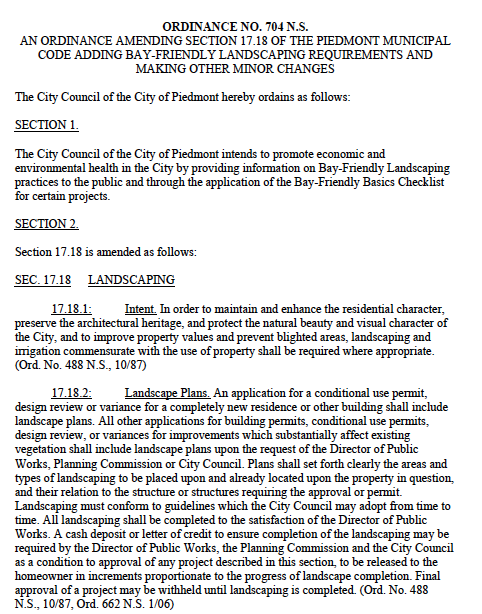
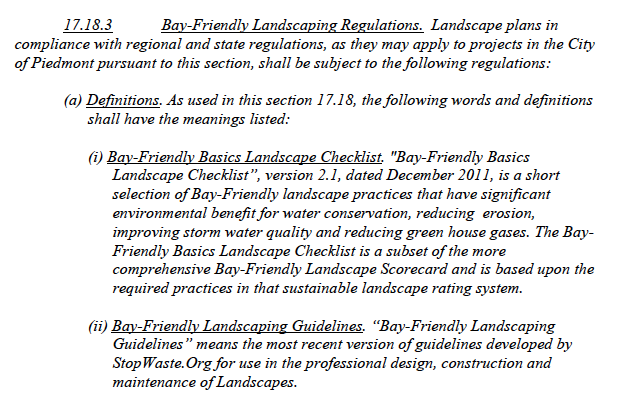
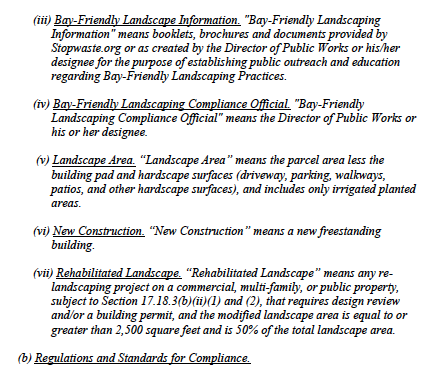
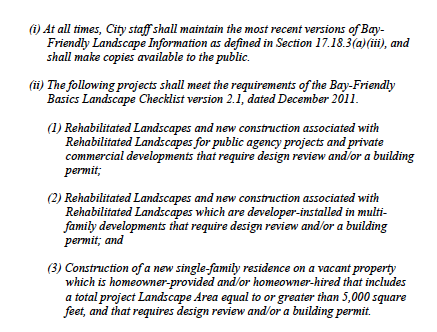
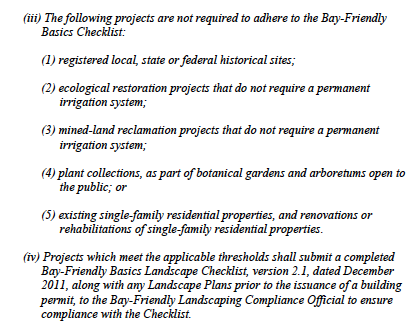
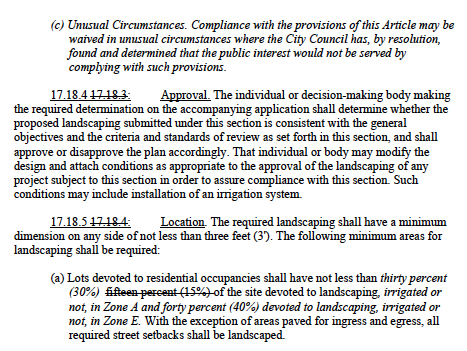
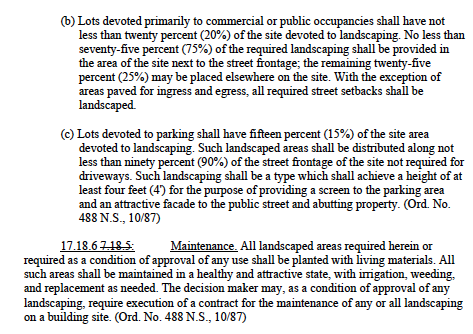
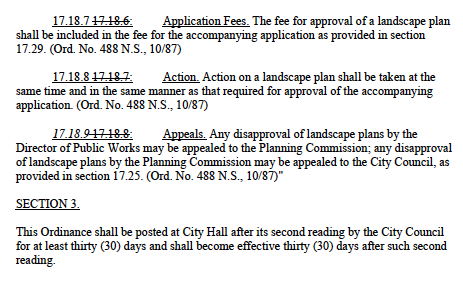
Comparison of Existing Landscape Ordinances
